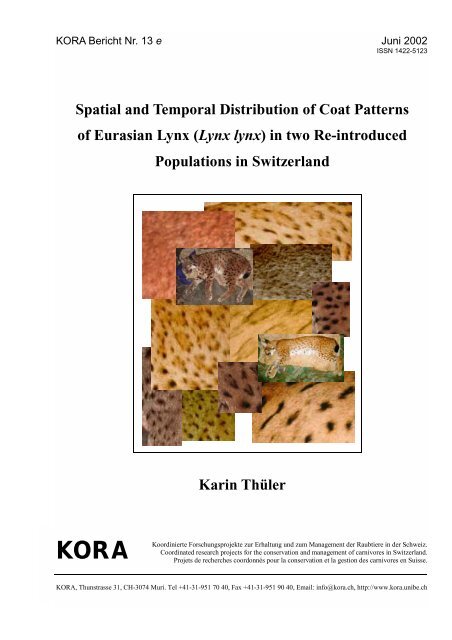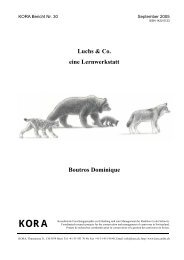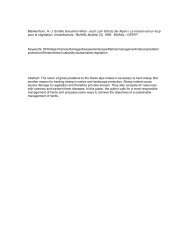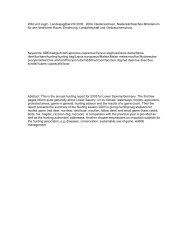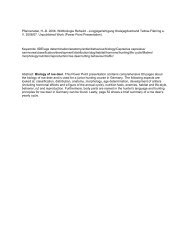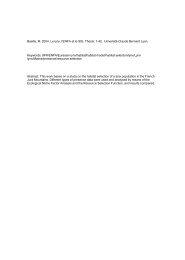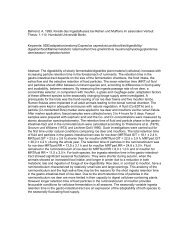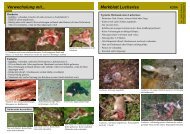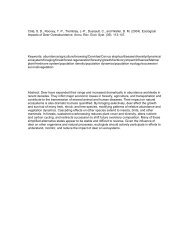Create successful ePaper yourself
Turn your PDF publications into a flip-book with our unique Google optimized e-Paper software.
KORA <strong>Bericht</strong> Nr. 13 e Juni 2002ISSN 1422-5123Spatial and Temporal Distribution of Coat Patternsof Eurasian Lynx (Lynx lynx) in two Re-introducedPopulations in SwitzerlandKarin ThülerKORAKoordinierte Forschungsprojekte zur Erhaltung und zum Management der Raubtiere in der Schweiz.Coordinated research projects for the conservation and management of carnivores in Switzerland.Projets de recherches coordonnés pour la conservation et la gestion des carnivores en Suisse.KORA, Thunstrasse 31, CH-3074 Muri. Tel +41-31-951 70 40, Fax +41-31-951 90 40, Email: info@kora.ch, http://www.kora.unibe.ch
2 KORA <strong>Bericht</strong> Nr. 13KORA <strong>Bericht</strong> Nr. 13 e:Spatial and Temporal Distribution of Coat Patterns of Eurasian Lynx (Lynx lynx) in two reintroducedPopulations in SwitzerlandAutorenAuteursAuthorsKarin ThülerAmselweg 23322 Schönbühlkarinthueler@bluemail.chBearbeitungAdaptationEditorialDamiano Torriani (Karten)Adrian Siegenthaler (Layout)BezugsquelleSourceSource<strong>Kora</strong>, Thunstrasse 31, CH-3074 MuriT +41 31 951 70 40 / F +41 31 951 90 40info@kora.chTitelfotoPhoto de la page de titreFront cover pictureDifferent coat pattern types of Eurasian lynxAnzahl Seiten/ Pages: 35ISSN 1422-5123©KORA Juni 2002
Juni 2002 3Spatial and Temporal Distribution of Coat Patterns ofEurasian Lynx (Lynx lynx) in two reintroducedPopulations in SwitzerlandDiploma ThesisFaculty of Science of the University of Bernpresented byKarin Thüler 2001Supervisor of the work:Prof. Dr. Marcel Güntert, Natural History Museum Bern
4 KORA <strong>Bericht</strong> Nr. 13AcknowledgementsI am grateful to the following persons who supported me during this study: Special thank to:• Dr. C. Breitenmoser-Würsten and Dr. U. Breitenmoser.• My supervisor Prof. Dr. M. Güntert who made-possible this diploma-thesis and for their comments and contributions.• J. Laass for helping with database and pictures.• E. Grégorova, Zoo Bojnice, Slovakia, C. Stanisa, Stara cerkev, Slovenia, D. Huber, Veterinary Faculty, Universityof Zagreb, Croatia and Aloizije Frkovic, Zagreb, Croatia for sending information about native lynx.• The Museum of Natural History in Berne, Dr. P. Lüps and M. Troxler for showing and helping me with skins,L. Schäublin for helping me with take pictures, V. Andres for helping me with literature.the Natural History Museum Basel, Dr. R. Winkler, Museum Gruérien Bulle, D. Buchs, Bündner Natural MuseumChur, Mr. Bardill, Natural Museum Thurgau, H. Geisser, Natural History Museum Fribourg, M. Beaud,Museum of Natural History Geneva, A. Keller, Museum of Natural History Lugano, S. Fossati, Natural MuseumLucerne, R. Heim, Museum of Natural History Neuchatel, Mr. Zimmerli, Natural Museum Olten, Dr. P.Flückiger and R. Leuenberger, Museum of Natural History Sion, J.-C. Praz, Natural Museum Solothurn, M.Winistörfer, Natural Museum St.Gallen, Dr. J. Barandun, Collection of Natural Science Winterthur, Mr. Fasnacht,Museum of Zoology University of Zurich, Dr. C. Claude.• Damiano Torriani for create overview Swiss-maps, colleagues from KORA (Coordinated research projects forthe conservation and management of carnivores in Switzerland, Muri b. Berne, Switzerland), Kim Baumann forcorrect my English, my family and friends.Digitale geographische Daten:Gewässer und politische Grenzen: © BFS GEOSTAT, © Bundesamt für Landestopographie;Ortschaft und Wald: Vector 200, © Bundesamt für Landestopographie;Höhenmodell: DHM25: © Bundesamt für Landestopographie; RIMINI: © BFS GEOSTAT.
Juni 2002 Content5Spatial and Temporal Distribution of Coat Patterns of Eurasian Lynx(Lynx lynx) in two reintroduced Populations in SwitzerlandContentAbstract 61. Introduction 61.1. Evolutionary history of coat patterns in felids 61.2. History of lynx in Switzerland and current status 62. Material and Methods 72.1. Available materials 72.2. Classification of Coat Patterns 82.3. Evaluation ans statistical analyses 83. Results 83.1. Identification of coat pattern types 83.2. Assignment of coat pattern types 93.3. Distribution of the different coat pattern types 93.3.1. Spatial distribution of coat patterns in Switzerland 103.3.2. Temporal changes in pattern type frequencies 104. Discussion 204.1. Description of coat pattern types 204.2. Comparisons with other descriptions of coat patterns in lynx 204.3. Spatial and temporal distribution of coat patterns in Switzerland 215. References 246. Appendices 25I Review on Coat Patterns. 25II Form with all necessary information needed per individual and guidelines to fill out the form 31III Spots-Counting rules 32IV Database of Lynx - Pictures 33
6 Abstract/IntroductionKORA <strong>Bericht</strong> Nr. 13AbstractLynx had become extinct throughout most of Centraland Western Europe at the end of the 19 th century. Thiswas also the case for Switzerland. However, in 1971the Eurasian lynx was reintroduced into the SwissAlps. Further re-introduction programs followed in theSwiss Jura Mts, Slovenia and Croatia. All animals releasedcame from the same source population of theCarpathian Mts in Slovakia, and some of them havebeen closely related. As small, isolated populations aretheoretically vulnerable to genetic drift, where alleleswith low frequency are likely to disappear from thepopulation gene pool, a change in the occurrence ofdifferent coat patterns can be an indication for this. Inthe recent population of the Swiss Alps a temporalchange of the occurrence of different coat pattern typeswas found. Another possible indication is the loss ofthe non-spotted type in the Jura Mts population.In this study, a classification system for coat patternsin lynx was developed and five different coat patternswere defined: large spots, small spots, withoutspots, rosettes and small spots with rudimentary rosettes.The frequency of occurrence of these coat patternswas then compared between the two reintroducedpopulations in Switzerland and the sourcepopulation in the Carpathian Mts of Slovakia and anotherre-introduced population in Slovenia/Croatia. Additionallycoat patterns of historic lynx from Switzerlandwere analyzed. The dominant coat pattern type inthe historic Swiss population was non-spotted and inrecent populations large-spotted. Rosettes were foundonly recently. There existed a correlation between spatialand temporal distribution of the different coat patterntypes.1. Introduction1.1. Evolutionary history of coat patterns in felidsCarnivores show a wide variety of pelage colors and agreat diversity of markings on their coat – includingspots, stripes, bands and patches (Ortolani & Caro1996) (Appendix I, 1.). The current theory of felid coatpattern evolution proposes that the primitive pattern isone of relatively large spots which have a tendency tobreak down, first by forming a lighter center and thenby breaking up into smaller spots spaced into rosettesand later individually. At each step in this general decayof the basic pattern, striped patterns may develop(Weigel 1961). Werdelin & Olsson (1997) coded thecoat patterns of felids into six discrete categories: uniform,flecks, rosettes, vertical stripes, small blotchesand blotches. It is generally accepted that specific colorpatterns in mammals are genetically determined but theactual mechanisms that create the patterns are still unknown.Lynx belong to the spotted cats. Their colorationcan differ widely. Coats of northern lynx are moregreyish and less spotted than in southern Europe wherethe color changes into reddish-brown (Breitenmoserand Breitenmoser-Würsten 1998). The Eurasian lynxpresents a high phenotypical variability within the species.Grégorova (1997) defined a hypothesis about anew type of pattern: In principle, it is possible to distinguishtwo basic types of patterns: spotted (small orlarge spots) as the most frequent one and without spotsas the rarest one. The third type is defined as an intermediatetype (rosettes). This „new” type has hypotheticallyevolved from hybridization of the previous twotypes. In some felid species (e.g. the pampas cat, Feliscolocolo) there exist a spatial pattern of different coatpatterns (Garcia-Perea 1994) (Appendix I, 2.).1.2. History of lynx in Switzerland and currentstatusUntil 1900 lynx was exterminated in Western andSouthern Europe. Some small populations survived inthe Balkan and the Carpathian Mts. In central Switzerlandlynx had already disappeared during 17 th century.In the Jura Mts the species survived until the beginningand in the Alps until the end of the 19 th century. Ragni(1993) analyzed coat patterns of the extinct Alpinepopulation and recognized a non-spotted type(concolor) as predominant and concluded that the Alpinelynx represented a differentiated taxon. In 1971,the Swiss government decided to re-introduce lynx intoSwitzerland and four years later the first animals havebeen released in the Alps (Breitenmoser 1983, Breitenmoserand Baettig 1992, Haller 1992). The animalsoriginated from the Carpathian Mts in Slovakia (zoo inOstrava). In addition to the official releases in Obwalden,Waadt and Neuenburg there were some illegal releasesin the Alps and in the Jura Mts (Breitenmoser1983, Haller 1992). In the founding population onlyvery few individuals were released. Additionally, accordingto Koubek and Cerveny (1996), some of themwere probably closely related (mother-son or siblings).Today, there are about 75–80 adult and subadult lynxliving in the Swiss Alps. The population in the JuraMts and in the Alps are still small and isolated andtherefore theoretically vulnerable to genetic drift,where alleles with low frequency are likely to disappearfrom the population gene pool (Griffiths et al.1996). Beltran and Delibes (1993) found preliminaryevidence for this in the Iberian lynx (Lynx pardinus) inCoto Doñana, Spain, where the population of approximately40–50 lynx was isolated since the early 1960s.A project on genetic variability, analyzing inbreedingproblems, shows that originally three coat patternswere present in the population, but today no animal exhibitsthe rare small-spotted pattern (Nowell & Jackson1996). In Switzerland intensive field studies since 1983
Juni 2002 Introduction / Material and Methods/7had provided extensive material on 87 lynx that werecaught over the years. At each capture, pictures of theanimals were taken. Anecdotal observations on differencesin coat patterns over space and time were madeduring the last few years.According to these observations, the following hypotheseswere formulated: i) Lynx have clearly distinguishablecoat patterns. (ii) The occurrence of thesedifferent types of coat patterns is different between thetwo re-introduced populations in Switzerland and haschanged over time since the releases in the early 1970s.(iii) Genetic drift has occurred since the releases due toa small founder population, and therefore the occurrenceof the different types of coat patterns in the reintroducedpopulations are different from the sourcepopulation in the Carpathian Mts of Slovakia. The aimof this study therefore was to (i) develop a classificationsystem for the different coat patterns observed andassign all available lynx individuals to a defined coatpattern type, (ii) compare the occurrence of these coatpatterns between the two re-introduced lynx populationsin Switzerland and the historic population and(iii) compare the occurrence of these coat patterns inSwitzerland with the occurrence in the source populationof Slovakia and another re-introduced populationin Slovenia/Croatia.2. Material and Methods2.1. Available materialsFor this study I collected all available information on342 individuals of the species Lynx lynx from populationsin Switzerland, Slovakia, Croatia and Slovenia(Table 1). I created a form with all necessary information(location [last origin, place where the lynx werecaught/found/dead, coordinates of caught/found], sex,age, year of birth, relatives) needed per individual andsent it to collaborators in Slovakia, Croatia and Slovenia(Appendix II). From museums of natural history inSwitzerland I also received a list with informationabout the lynx specimens stored. All this informationwas collected in a table where I setup a database(Microsoft Access) with all available lynx that couldprovide information on coat patterns from Switzerland(Appendix IV).From the two Swiss populations, pictures from captures,photo traps, video recordings and mortalitieswere available. From dead lynx stored in museums, Ifirst had to take pictures of pelts and mounts. A standardizedprocedure was applied: Using a grey cloth asbackground (only with pelts) and next to every objecton every picture placed a ruler. The camera was aNikon FE2 with a 55 macro lens (28-85, 70-210) and aTable 1. All available specimen.Material Type of specimen Number of specimenSwitzerland Total 228Monitored lynx in telemetry project Pictures from captures (various field studies in Switzerland) 87Photo-trapsPictures from photo traps (population estimation study, predatoridentification program)Video Pictures from videos (predator identification program) 9Lynx in museum Lynx hides and stuffed specimen in museums in Switzerland :MountsPeltsAnimals not yet mountedOther dead lynxPictures from dead lynx (<strong>Kora</strong>'s database of dead lynx), pelts,mountsSlovakia Total 47Lynx in Zoo Pictures of animals 5Lynx in private Pictures of pelts 2Dead lynx Pictures of pelts 40Croatia Total 45Lynx pelt of hunter Pictures of pelts and mounts 45Slovenia Total 22Lynx in zoo Pictures of animals 5Lynx in wild cat project Pictures of animals 1Monitored lynx in telemetry project Pictures of captures 4Dead lynx Pictures of pelts 12134351223Total Objects 342
8 Material and Methods / ResultsKORA <strong>Bericht</strong> Nr. 13Nikon SB-15 flesh and the film a Kodak ProfessionalPORTRA, ISO 160vc, 135mm. I took pictures from thefollowing body/coat areas: left and right, shoulder/upper arm, forearm, hand, femur/hip, lower leg, foot,flank and dorsum and the complete left and right side.The pictures were made in daylight. All pictures werescanned and saved in a jpg-format. From Collaboratorsin Slovakia, Slovenia and Croatia I had alreadyscanned pictures saved in a jpg-format.2.2. Classification of Coat PatternsI intuitively deducted 5 different coat pattern types:type 1 as “large spots”; type 2 as “small spots”; type 3as “without spots” and two types of rosettes: type 4a as“clear rosettes” and type 4b as “spots with rudimentaryrosettes” and chose typical representatives of everytype.To describe these 5 types I counted the number ofspots on 6 selected areas of the body surface, accordingto anatomical criteria: left/right, shoulder, upper armand forearm (L/R1); left/right flank and back (L/R2),left/right femur, hip and lower leg (L/R3) (Figure 1). Inthis areas the typical coat pattern type was represented.The area next to the backbone and the ventral-side(white coat color) depending on the posture of the individual,was not visual on several pictures. So I did notuse these areas for analyses. Spots were counted afterdefined rules. Large or small spots: every identifiablesingle spot and spots in V-form were counted as onespot. Spots in rosettes or in rudimentary rosettes: everyidentifiable spot arranged in rosettes/small blotcheswas counted as one spot. Spots arranged in groups:every identifiable spot arranged in strips or other arrangementswas counted as one spot. Strips where nointerception was identifiable was counted as one spot.Coats without spots: no counting of spots (AppendixIII). To verify the measurements and countability ofcounting the first 10 objects I counted three times andcalculated the mean value. Also coats with undistinguishableor bleached patterns I counted three times.As reference to the degree of bleaching of pattern Iused the black tail color and its degree of bleaching. Todistinguish between large and small spots I randomlymeasured the diameter of 10 spots (randomly distributedover the body) of 12 individuals, 6 typical largeand 6 typical small spots and calculated the meanvalue.2.3. Evaluation and statistical analysesThe differences in number of spots in the six body/coatarea were tested by Kruskal-Wallis-Test. The Principal-Component-Analysiswas used to test differencesbetween the coat pattern types based on the total numberof spots and the existence of rosettes. To comparedata of the five populations (historical and recent SwissAlps, Jura Mts, Slovakia, Slovenia/Croatia) I used theχ-square-test. For tests of normality I used the Kolmogorov-Smirnov-test.Figure 1. The six selected areas of the body/coat (dotted areas):left/right, shoulder, upper arm and forearm (L1/R1);left/right flank and back (L2/R2) and left/right femur, hipand lower leg (L3/R3).All available lynx were assigned after a createdpath-diagram based on the description of the five differentcoat pattern types. To evaluate the spatial distributionI only used individuals with known location(last origin, place of caught/found/dead, coordinates ofcaught/found) and for temporal analyses individualswith known year of birth.3. Results3.1. Identification of coat pattern typesFrom 148 individuals, I counted the number of spots insix different body/coat areas. This method proved to beuseful and applicable. The mean value was calculatedof the same area between the left and right side([L1+R1]/2, [L2+R2]/2, [L3+R3]/2) and the total numberof spots of every individual.The number of spots per body/coat area of type 1and 3 were significantly different to all other types(Mann-Whitney-U-test, P < 0.1, bilateral) and also betweeneach other. Type 2, 4a and 4b were significantlydifferent to type 1 and 3 but tested against each otherthere was no significant difference between the numberof spots per body/coat area (Mann-Whitney-U-test, P >0.1, bilateral) (Table 2, Figure 2). To distinguish betweenthe five different types another criterion wasneeded: the Principal-Component-Analysis assorted theindividuals in groups which showed the intuitive deductedcoat pattern types, based on the total number ofspots per individual and the existence of rosettes. Thefirst principal component explained 82.76 % of varianceand the second 6.58 % (Figure 3). The untypicalallocations showed juveniles which have less spots accordingtheir smaller bodies. One untypical allocatedtype 3 showed an individual which had no spots onshoulders, flanks and hips but more than the average onthe upper arms, femurs and legs.
Juni 2002 Results9Table 2. Statistical analysis of the total number of spots per coat pattern type (n = 148).Coat pattern type Median 25% Quartile 75% Quartile min maxType 1 316.50 294.00 349.75 130.00 430.00Type 2 528.00 477.00 660.00 309.00 812.00Type 3 183.50 136.50 219.00 84.00 492.00Type 4a 630.00 586.00 714.00 335.00 812.00Type 4b 581.00 520.00 648.00 168.00 804.00number of spots per body area160.00100.0050.000.00Type 1 L/R1Type 1 L/R2Type 1 L/R3Type 2 L/R1Type 2 L/R2Type 2 L/R3Figure 2. Number of spots per body/coat area of the fivecoat pattern types (L1/R1: left/right shoulder, upper arm andforearm; L2/R2: left/right flank and back; L3/R3: left/rightfemur, hip and lower leg, Figure 1).With all this information the five coat pattern typeswere consequently definitively defined (Table 3): type1 with large spots (Figure 4), type 2 with small spots(Figure 5), type 3 without spots on shoulders, flanksand hips but spots on upper arms, femurs and legs(Figure 6). In type 4 (rosettes) I distinguished twotypes: type 4a with clear rosettes or small blotches(single spots were no more visual and the rosettesshowed circle-forms) (Figure 7) and 4b with smallspots and rudimentary rosettes (single spots were visualwithin rosettes) (Figure 8). The definition containedsize, form, number, color and distribution of spots inthe following body/coat areas: shoulder / upper arm,forearm, hand, femur / hip, lower leg, foot, flank anddorsum.3.2. Assignment of coat pattern typesTo assign all available individuals to one of the fivecoat pattern types it was important to look at all body/coat areas. Each coat pattern type showed variation andonly the analysis of the complete body allowed the assignmentto one type. According to the analysis ofnumbers of spots and the definition of types I created apath-diagram (Figure 9). First question: “are spots vis-Type 3 L/R1Type 3 L/R2Type 3 L/R3Type 4a L/R1Type 4a L/R2Type 4a L/R3coat pattern type and body areaType 4b L/R1Type 4b L/R2Type 4b L/R3ual on flanks or not?” (type 3 can be separated from theother four types); second question: “are rosettes identifiableor not?” (type 1 and 2 can be separated fromtype 4a and 4b). The question decision is between type1 and 2, concerns the size and number of spots and betweentype 4a and 4b about the clearness of rosettes.From a total of 342 individuals, 4 individuals (1.2%)could not be assigned to one of the five types. Betweenfemales (n = 70) and males (n = 53) (unknown n = 28)(df = 4, χ 2 = 2.6, P > 0.5) and young (juveniles &subadults, n = 55) and adult (n = 82) (unknown n= 14)animals (df = 4, χ 2 = 1.89, P > 0.5) there was no significantdifference. Consequently all individuals werepooled, including those with unidentifiable age andsex.3.3. Distribution of the different coat pattern typesData from six different populations were available(historical Swiss population, n = 21; recent populationof the Swiss Alps, n = 128; Jura Mts population, n =44; Slovakian population, n = 47; Slovenian population,n = 22; Croatian population, n = 45; total individuals:306, from 32 of total 338 assigned individualsno location data were available or they originated fromzoo populations, which I did not use). Lynx from Sloveniaand Croatia belong to the same re-introducedpopulation. As the occurrence of different coat patternsdid not differ between the two subsamples ( df = , χ 2 =5.52, P > 0.05), these animals were subsequentlypooled. Rosettes have shown up only in recent populations.However, coat pattern type 4a and 4b have onlyreached a considerable proportion in the re-introducedpopulation in the Alps (46% vs. 18-28%). For furtheranalyses type 4a and 4b were also pooled to “type 4”.The animals re-introduced into Switzerland and Slovenia/Croatiaoriginated from the same source populationin the Carpathian Mts of Slovakia. The comparisonbetween the source population in Slovakia and there-introduced population in the Jura Mts (df = 3, χ 2 =5.01, P > 0.05) and the population in Slovenia/Croatia(df = 3, χ 2 = 2.96, P > 0.05) showed a similar occurrenceof the four different coat pattern types (Figure10). In all three populations type 1 was dominant (over60%). Type 4 was represented between 18-28% andType 2 and 3 about 10%. A different development wasfound in the population of the Swiss Alps (df = 3, χ 2 =8.58, P < 0.05). Predominant was type 4 (46%). Type 1
10 ResultsKORA <strong>Bericht</strong> Nr. 13was represented with 35% and type 2 and 3 with togetherwith 18.75%.The comparison between the re-introduced populationof Slovenia/Croatia and the population of theSwiss Alps showed a significant difference betweenthe different coat pattern types (df = 3, χ 2 = 20.29, P 0.1). The occurrences of the 4 coat patterntypes showed same ratios.3.3.1. Spatial distribution of coat patterns in SwitzerlandAnalyses of the spatial distribution in Switzerland resultedin a significant difference in the frequency of thefour coat pattern types between the Jura Mts populationand population of the Swiss Alps (df = 3, χ 2 = 24.35, P< 0.001). In the Jura Mts type 1 was dominant (77%)and type 4 were found in only 9 of 44 (20%) individuals.In the Swiss Alps the frequency showed the opposite:type 1 was found in 35% and type 4 in 59 of 128(46%) individuals (Figure 10). In the population of theSwiss Alps all of the five types (1, 2, 3, 4a, and 4b)were found. In the Jura Mts the coat pattern type withoutspots (type 3) is no longer present and the one withsmall spots (type 2) is very rare (2%).The range of the re-introduced population of theSwiss Alps is highly topographically structured. Toanalyse the spatial distribution of the different coat patterntypes, the range was divided into four regions(Figure 11). The occurrence of different types in theregion of Berne, Waadt, Fribourg (NWA) and Wallis(SA) showed no difference (df = 3, χ 2 = 1.59, P > 0.5).Between the Central Alps (CA) and NWA/SA the frequencyof coat patterns was just not significant (df = 3,χ 2 = 6.57, P > 0.05). A high significantly different frequencyof coat pattern types was found between thepopulation of the Swiss Alps and the Jura Mts population(df = 3, χ 2 = 27.2, P < 0.001).3.3.2. Temporal changes in pattern type frequenciesBefore 1908, in the historic population 15 of 21 (71%)individuals showed type 3 (without spots) and only 4(19%) type 1 (large spots). Type 4 did not exist. Reintroducedlynx (after 1972) were of completely differentpattern types than the historic individuals (SwissAlps, df = 3, χ 2 = 55, P < 0.001; Jura Mts, df = 3, χ 2 =45.6, P < 0.001). In the recent population of the SwissAlps 45 of 128 (35%) individuals showed type 1 andonly 10 (8%) type 3, moreover type 4 was found in 59of 128 (46%) individuals. The frequency of type 2 waslow in all populations (historical Alps: 2 of 21[9.5%],recent Alps: 14 of 128 [11%], Jura Mts: 1 of 44 [2%]).During the fist decade after the re-introduction thevariety of types increased, and after 20 years all fivetypes were present in the Swiss populations. To analysethis change more in detail frequencies were analyzedin 10 year intervals (1970-1979, 1980-1989 and1990-1999). In the late 70s type 1 had become rare andtype 3 had completely disappeared. During the 90s thefrequency of type 4 increased distinctly. These temporalchanges were only found in the population of theSwiss Alps. In the Jura Mts the database was too small.The temporal change correlated with the spatial distribution.The frequency of coat patterns in the 1970sshowed the distribution in Central Switzerland. Thedistribution in the North-west and South Alps reflectedthe 1990s.Figure 3. Principal-Component-Analyse. Everysymbol shows a single individual which is assortedafter the total number of spots and the existenceof rosettes. The first principal componentexplains 82.76 % of variance, the second 6.58 %.
Juni 2002 Results11Table 3. Description of Coat Pattern TypesCoat pattern type Spots Shoulder / upperarmType 1:Large spotsTotal spots:Ø: 317Type 2:Small spotsTotal spots:Ø: 528Type 3:Without spotsTotal spots:Ø: 184size large spots,Ø: 1,6-3 cmform round, V-form(open to thehead) or otherdifferent spotformationsForearm Hand Femur / hip Lower leg Foot Flank Dorsumlarge spots,Ø: 1,6-3 cmsmall spots,Ø: < 0,5 cmlarge spots,Ø: 1,6-3 cmlarge spots,Ø: 1,6-3 cmno spots large spots,Ø: 1,6-3 cmround round round round - round or spots organizedinto strips of 5 orfewer spotslarge spots,Ø: 1,6-3 cmnumber Ø: 58 spots (L/R 1) Ø: 25 spots Ø: 55 spots (L/R 3) - Ø: 48 spots (L/R 2)color black black black black black - black blackdistribution irregular regular regular regular regular - irregular regularsize small spotsØ: < 1,5 cmform round, rarelystrip-formationsmall spotsØ: < 1,5 cmsmall spots,Ø: < 0,5 cmsmall spotsØ: < 1,5 cmsmall spotsØ: < 1,5 cmno spots small spotsØ: < 1,5 cmround round round round - round, rarely stripformationround or spots organizedinto strips of 7 orfewer spotssmall spotsØ: < 1,5 cmnumber Ø: 87 spots (L/R 1) Ø: 25 spots Ø: 100 spots (L/R 3) - Ø: 82 spots (L/R 2)color black black black black black - black or brownish blackdistribution regular regular regular regular regular - regular regularsize no spots butsome smallspots on theelbow,spots Ø: < 1 cmsmall spotsØ: < 1 cmsmall spots,Ø: < 0,5 cmno spots butsome smallspots on theknee,spots Ø: < 1 cmsmall spots,Ø: < 0,5 cmno spots no spots but somesmall spots on theventral side,spots Ø: < 1 cmform round round round round round - round -number Ø: 33 spots (L/R 1) Ø: 25 spots Ø: 32 spots (L/R 3) - Ø: 19 spots (L/R 2) -color black black black black black - black -distribution regular regular Regular regular regular regularround, rarely stripformationno spots
12 ResultsKORA <strong>Bericht</strong> Nr. 13Table 3. (cont.) Description of Coat Pattern TypesCoat pattern type Spots Shoulder / upperarmType 4a:RosettesTotal spots:Ø: 630Type 4b:Small spots withrudimentary rosettesTotal spots:Ø: 581size small spotsØ: 1-2 cmform rosettes: smallspots organizedinto patterns of3-7 spots,irregularly spotformationsForearm Hand Femur / hip Lower leg Foot Flank DorsumIrregular smalland larger spotsround or longishsmall spots,Ø: < 0,5 cmsmall spotsØ: 1-2 cmround rosettes: smallspots organizedinto patterns of3-7 spots,irregularly spotformationssmall spotsØ: 1-2 cmround orwashed outno spots small spotsØ: 1-2 cm- rosettes: small spotsorganized into patternsof 3-7 spots,irregularly spot- formationsnumber Ø: 100 spots (L/R 1) Ø: 25 spots Ø: 116 spots (L/R 3) - Ø: 103 spots (L/R 2)color spots: blackrosettes: insidebrownishblack black spots: blackrosettes: insidebrownishblack orbrownish- spots: blackrosettes: insidebrownishdistribution irregular regular regular irregular irregular - irregular irregularsize small spotsØ: 1-2 cmform round or irregularspot- andrudimentaryrosettes(small spotsorganized intopatterns of 3-7spots)small spotsØ: < 1 cmsmall spots,Ø: < 0,5 cmsmall spotsØ: < 1 cmround round round or irregularspot- andrudimentaryrosettes(small spotsorganized intopatterns of 3-7spots)small spotsØ: < 1 cmno spots small spotsØ: 1-2 cmround - round or irregularspot- and rudimentaryrosettes (small spotsorganized into patternsof 3-7 spots)irregular small or largerspots or strips,spots: Ø: 1-2 cmstrips: w: 0,5-1 cm,l: 3-7 cmrosettes,round spots or stripsspots and strips: blackrosettes: insidebrownishsmall spotsØ: < 1 cmnumber Ø: 95 spots (L/R 1) Ø: 25 spots Ø: 102 spots (L/R 3) - Ø: 93 spots (L/R 2)color black black black black black - black blackdistribution irregular regular regular irregular irregular - irregular irregularround or irregularspot- and rudimentaryrosettes(small spots organizedinto patterns of3-7 spots)
Juni 2002 Results13Type 1: large spotsShoulder / upper arm Forearm / hand Femur / hipFlankLower leg / footBackFigure 4. Description of type 1: large spots.
14 ResultsKORA <strong>Bericht</strong> Nr. 13Type 2: small spotsShoulder / upper arm Forearm / hand Femur / hipFlankLower leg / footBackFigure 5. Description of type 2: small spots.
Juni 2002 Results15Type 3: without spotsShoulder / upper armFemur / hipFlankForearm / handLower leg / footBackFigure 6. Description of type 3: without spots.
16 ResultsKORA <strong>Bericht</strong> Nr. 13Type 4a: rosettesShoulder / upper arm Forearm / hand Femur / hipFlankLower leg / footBackFigure 7. Fig. Description 9. There of was type no 4a: significant rosettes. correlation between the distances from the den sites to the water bodies andthe precipitation (water shortage).
Juni 2002 Results17Type 4b: small spots with rudimentary rosettesShoulder / upper arm Forearm / hand Femur / hipFlankLower leg / footBackFigure 8. Fig. Description 9. There of was type no 4b: significant small spots correlation with rudimentary between the rosettes. distances from the den sites to the water bodies andthe precipitation (water shortage).
18 ResultsKORA <strong>Bericht</strong> Nr. 13Spots on flanksnoyesType 3Spots in Form ofRosettesnoyesSpots < Ø 1.6 cmNumber of spots > Ø 422Clear rosettes(small blotches)noyesnoyesType 1 Type 2Type 4bType 4aFigure 9. Path-diagram for assigning all available lynx to one of the five coat pattern types. Type 1: large spots, type 2: smallspots, type 3: without spots, type 4a: rosettes and type 4b: small spots with rudimentary rosettes.?? Type 1: large spots?? Type 2: small spots?? Type 3: without spots?? Type 4a: clear rosettes?? Type 4b: small spots withrudimentary rosettesNumber of Individuals5248444036322824201612840286 742Slovakia (n=47)Source-PopulationNumber of Individuals52484440363228242016128404514Alps CH1029 30(n=128)Number of Individuals5248444036322824201612840341 0Jura CH4 5(n=44)Number of Individuals524844403632282420161284044742Slovenia / Croatia (n=67)10Figure 10. Frequency of the various coat pattern types in Swiss and European populations (recent population of the SwissAlps; Jura Mts population; Slovakian population; Slovenian/Croatian population; total individuals: n = 307).
Juni 2002 Results19Figure 11. Distribution of coat pattern types in recent lynx populations in Switzerland (CA: Central Alps; NWA: North westAlps with Berne, Fribourg and Waadt; SA: South Alps, Wallis; n = 185).?? Type 1: large spots ?? Type 2: small spots ?? Type 3: without spots?? Type 4a: clear rosettes ?? Type 4b: small spots with rudimentary rosettesNumbers of Individuals in %100%80%60%40%20%7 82331112 411111431613181144264 7 83861412212510252270%111802-1850(n=10)1851-1900(n=11)1970-1971(n=0)1972-1973(n=3)1974-1975(n=3)1976-1977(n=6)1978-1979(n=3)1980-1981(n=7)1982-1983(n=10)1984-1985(n=4)1986-1987(n=9)1988-1989(n=6)1990-1991(n=12)1992-1993(n=15)1994-1995(n=28)1996-1997(n=30)1998-1999(n=18)Time PeriodeFigure 12. Changes in the frequency of the different coat pattern type from 1802 – 1999 in Switzerland (n = 175).
20 DiscussionKORA <strong>Bericht</strong> Nr. 134. Discussion4.1. Description of coat pattern typesWerdelin & Olsson (1997) coded felid coat patternsinto six discrete categories: flecks (small spots not organizedinto patterns), rosettes (small spots arrangedinto patterns of six or fewer spots), small blotches(small irregularly shaped areas of dark on a usuallylighter background), blotches (large areas of variablecolor framed by dark and set on a lighter background),vertical stripes (dark, dorsoventrally or anterodorsallyposteroventrallydirected stripes on a lighter background)and uniform (no distinguishable pattern)(Figure 13). My definitions of the five coat patterntypes corresponds to Werdelin & Olsson’s followingtypes: type 1 and 2, “large and small spots” correspondto “flecks”; type 3, “without spots” to “uniform”;type 4a, “clear rosettes (small blotches) to“small blotches” and type 4b “small spots with rudimentaryrosettes” correspond to “rosettes” (Figure 14).Werdelin and Olsson (1997) looked at the coat patternsof living cat species in conjunction with the evolutionaryrelationship within the cat family to estimatehow often each type of pattern had given rise to each ofthe others and used clad. meth. of phyl. inf. to reconstructhistorical events in a phylogenetic framework.Because small flecks gave rise to large spots, rosettes,stripes and blotches much more frequently than any ofthe other possible transitions, they suggest that thecommon ancestor of modern cats, rather than havinglarge spots which broke apart later, was patterned withsmall flecks. As cats evolved, the flecks coalesced intolarger blotches, rosettes or stripes. Lynx coat patternmay have developed after this hypothesis. On the otherhand, Weigel (1961) proposed a felid coat pattern evolutionfrom a primitive form with large spots to smallerspots spacing into rosettes, and then striped patternsmay have developped (Figure 15).4.2. Comparisons with other descriptions of coatpatterns in lynxSeveral authors observed and described different coatpatterns of Eurasian lynx during the last century (Table4). Most of them observed three different types of patterns:large spots, small spots and without spots but therosette-spotted types has not been described in details.The descriptions differ widely. Only the large spottedtype was always exactly recognized and described. Inmost of the descriptions variations of the same typewere defined as other types. Grégorova (1997) defineda hypothesis about a new type of pattern: intermediate(rosettes) type. This type has hypothetically evolvedfrom hybridisation of a spotted and a non-spotted type.Different frequencies of coat patterns in the Eurasianlynx in different areas of its range were analyzedby several authors. The observed types were large-,small- or non-spotted. The frequencies differed immenselybut geographical trends have been found(Table 5). In the Carpathian Mts the large-spotted typeshowed a high frequency. In Western and NortheasternSiberia and in Central Asia type 3, withoutspots, was mostly observed. Type 2 showed generally alow frequency.Figure 13. The six different coat patterns in felids. Left column, top to bottom, flecks, rosettes, verticalstrips; right column, top to bottom, small blotches, blotches, uniform. After Werdelin & Olsson (1997).
Juni 2002 Discussion21Figure 14. The four different types of spots in lynx coat patterns: spots correspond to flecks, (included smalland large spots), without spots correspond to uniform, clear rosettes (small blotches) correspond to smallblotches and rosettes or rudimentary rosettes correspond to rosettes. Left pictures top to bottom after Werdelin& Olsson (1997).4.3. Spatial and temporal distribution of coat patternsin SwitzerlandIn 1971 the Eurasian lynx was re-introduced into theSwiss Alps and initially, had spread quite fast over thewestern Alps and the Jura Mts but since the mid 1980s,the population expansion came to a halt, even thoughthere were still large areas of suitable habitat not yetoccupied in eastern Switzerland (Breitenmoser 1983,Haller 1992). Though the re-introduced individuals inthe Jura Mts and population of the Swiss Alps originatedfrom the same source population, the CarpathianMts of Slovakia, the development of the frequency indifferent coat pattern types differed widely. Before theextermination the range of the Eurasian lynx extendedthroughout Europe (Nowell & Jackson 1996) thereforethe historic Swiss population belonged to the sameCarpathian population as the Slovakian population.The change of the occurrence of different types developedfrom type 3, without spots, in the historical populationto type 1, large spots, in the early re-introducedpopulation, then to type 2, small spots, and finally totype 4a and 4b, rosettes and rudimentary rosettes, inlate re-introduced or recent populations. Ragni (1993)analyzed coat patterns of the extinct Alpine population.
22 DiscussionKORA <strong>Bericht</strong> Nr. 13He recognized a non-spotted type (concolor) as beingpredominant.In the source population all five types were present,also in the re-introduced populations in Slovenia/Croatia and the Swiss Alps but the frequency is different.In the Jura Mts, the bottleneck created by the reintroductionlead to the loss of one coat pattern type:type 3. The population of the Iberian lynx (Lynx pardinus)with approximately 40-50 individuals was isolatedsince the early 1960s. Originally thee coat patternswere present but today no animal exhibits the raresmall-spotted pattern (Beltran and Delibes, 1993). Inthe Swiss Alps population, the frequency of the coatpattern types had significantly changed compared withthe source and the historical population. A probablyaggravated exchange is possible between the Centraland NW-Alps but between Jura Mts and Alps no exchangeis possible because of the topography. Thereforethe two populations are still small and isolated.Effects of genetically drift is found in both populationin Switzerland: in the population of the Swiss Alps, apostponement of frequencies of coat pattern types wasfound. In the Jura Mts the genetically drift resulted in aloss of one coat pattern type.Small, isolated sub-populations are vulnerable togenetic drift. Alleles with low frequency are likely disappearedfrom the population gene pool (Griffiths et al.1996).Color patterns in felids are genetically determinedbut the actual mechanisms that create the patterns arestill unknown. Definitive conclusions about the reasonfor the change of the occurrence of the different coatpattern types can be made after genetically analyses, sothe results will be linked to a study on populations geneticsof Swiss populations. Analysis of known pedigreesfrom field studies in Switzerland and in zooscould contribute to the knowledge of the mechanismsbehind the transmission of coat patterns.Figure 15. The current hypothesis of coat pattern evolution in Felidae. AfterWeigel (1961).
Juni 2002 Discussion23Table 4. Descriptions of coat patterns of Eurasian Lynx.Ognev (1935)Stollman (1963)Central Russian lynx: a) some with more dark patterns of bands and spots; b) some have an almostuniform color without spottiness on trunk.Carpathian Lynx: a) characteristic spots (the spots form long strips on the dorsum and on the flanksthe spots are almost round); b) less spotted; c) without spots (uniform: the spots appear only indicated,on the legs, shoulder and belly the spots appear clearer).Vasiliu & Decei (1964) Rumanian Carpathian Mts: a) spots (well developed all over, specially on the dorsum and flanks); b)small spots; c) without spots (on the dorsum and only pale spots on the flanks).Matjuschkin (1978) Coat pattern types: a) large and clear spots; b) small but clear spots and small stripes on the back; c)without spots on the back but with spots on the legs; d) and without spots all over.Miric (1978)Ragni et al. (1993)Grégorova (1997)Balkan lynx: a) large spots (intensive colored spots, rarely placed); b) small spots (pale, small anddensely placed spots); c) weak spots (lack of spots on the back and flanks).Eurasian lynx: spotted (permanent black spots), striped (the pattern is arranged in horizontal stripesand bars of permanent-evanescent) and concolour (without markings in the somatic regions or with apattern so scattered and obsolescent that it cannot be defined).Coat pattern types: a) spotted (small or large spots), b) without spots, c) intermediate type (rosettes,hypothetically evolved from hybridization of the previous two types).Table 5. . Frequency of the different coat patterns of Eurasian lynx in different areas of its range. Description of coat patterntypes a–d: see Table 4. x = frequency unknown.Region Author large spots small spotsnot spotteda b c dThe Balkans Miric (1978) 31.83 %Carpathian Mts Stollmann (1963) (CSSR) 90.00 % x xKunc (1971) 67.70 % 22.60 % 9.70 %Matjuschkin (1978) x x - -Kaukasus 33.00 % x 14.00 %Iberian lynx x x - -Western Siberia 17.00 % 3.00 % 60.00 % 20.00 %Sajanen/Baikal 27.00 %Siberia 36.00 % 38.00 %Jakutien/Amur - - x xAltai - - x xTienschan-Saur/Altau 10.00 % x 65.00 %Central Asia - - 27.00 % 73.00 %Northern Mongolia Formosow (1929) - - x xBannikow (1954) - - x xNorth-eastern Siberia Kistschinski (1967) 22.20 % 77.80 %
24 ReferencesKORA <strong>Bericht</strong> Nr. 135. ReferencesBannikow, A. G. 1954. Die Säugetiere der MVR. TrudyMong. kom. Ak. Nauk SSSR Moskau 53.Beltran, J. F. and M. Delibes, 1993. Physical characteristicsof Iberian Lynxes (Lynx pardinus) from Doñana, southwesternSpain. J. Mamm. 74 (4): 852–862.Breitenmoser, U. 1983. Zur Wiedereinbürgerung und Ausbreitungdes Luchses (Lynx lynx L.) in der Schweiz.Schweiz. Z. Forstwes. 134: 207–222.Breitenmoser, U. and M. Baettig, 1992. Wiederansiedlungund Ausbreitung des Luchses Lynx lynx im SchweizerJura. Revue suisse Zool. 99: 13–176.Breitenmoser, U. and Ch. Breitenmoser-Würsten, 1998. DerLuchs. Biologie einheimischer Wildtiere 1/10a, Zürich.Formosow, A. N. 1929. Die Säugetiere der nördlichen Mongoleinach dem Material der Expedition vom Jahre 1926.Predvar. Otcet zool. Eksped. V Sev. Mongoliju. Leningrad.Garcia-Perea, R. 1994. The Pampas Cat Group (genus LynchailurusSevertzov, 1858) (Carnivora: Felidae), a systematicand biogeographic review. American Museum ofNatural History Nr 3096: 1–35 (New York).Garcia-Perea, R. 1994. Pampas Cats: how many species?.Cat News 20: 21–24.Grégorova, E. 1997. Lynx, Zoological Garden Bojnice.Griffiths, A. J. F. et al. 1996. An Introduction to GeneticAnalysis. Sixth Edition. W. H. Freeman and Company,New York.Haller, H. 1992. Zur Ökologie des Luchses (Lynx lynx) imVerlauf seiner Wiederansiedlung in den Walliser Alpen.Mammalia depicta 15: 1–62.Kistschinski, A. A. 1967. Zur Verbreitung und intraspezifischenVariation des Wolfs, Vielfrasses und Luchses aufdem Kolyma-Plateau und im Kolyma-Gebirge. In: Ekologijamlekopitajuschich i ptic. Pages 10–16. Moskau.Koubek, P. and J. Cerveny, 1996. Population developmentand recent distribution of the lynx (Lynx lynx) in theCzech republic. ACTA Scjentiarum natura 3: 2–15, Liumacademiae scienti arum bohemicae Brno.Kunc, L. 1971. Individualni variabilita zbarveni rysa ostrovida(Lynx lynx) Karpatske oblasti. Lynx n. s. 12: 60–65.Matjuschkin, E. N. 1978. Der Luchs. A. Ziemsen Verlag,Wittenberg Lutherstadt, Germany, 160 pp.Miric, D. J. 1978. Die Luchspopulationen der Balkanhalbinsel.Serbian Academy of Sciences and Arts, Vol.DXXXIX, (55): 150 pp.Nowell K. and P. Jackson 1996. Wild Cats. InternationalUnion for Conservation of Nature and Natural Resources,110 pp.Ognev, S. L. 1935. Mammals of USSR and adjacent countries.Vol. 3: 165–186, Carnivora, Moscow.Ortolani, A. and T. Caro, 1996. The Adaptive Significanceof Color Patterns in Carnivores: Phylogenetic Tests ofClassic Hypotheses. In: Gittleman J. L. (ed.) CarnivoreBehavior, Ecology, and Evolution, Vol. 2: 132–188.Ithaca, Cornell University Press.Ragni, B., M. Possenti and S. Mayr, 1993. The Lynx in theItalian Alps. Cat News 19: 21–25.Stollmann, A. 1963. Beitrag zur Kenntnis des Luchses, Lynxlynx in den tschechoslowakischen Karpaten. Folia Zoologica,Brünn (Brno), 12: 301–316.Vasiliu, G. D. and P. Decei, 1964. Über den Luchs (Lynxlynx) der rumänischen Karpaten. Säugetierkundliche Mitteilungen,München, 12: 155–183. (Bukarest).Weigel, I. 1961. Das Fellmuster der wildlebenden Katzenartenund der Hauskatze in vergleichender und stammesgeschichtlicherHinsicht. Säugetierkundliche Mitteilungen,München, 120 pp.Werdelin, L. and L. Olsson, 1997. How the Leopard got itsspots: a phylogenetic view of the evolution of felid coatpatterns. Biological Journal of the Linnean Society 62:383–400.
Juni 2002 Appendix I25Review coat patterns (supplementation of the Introduction)1. General statements on coat patterns in mammalsMammals exhibit a remarkable variety of coat patterns(Murray 1988). Especially carnivores show a wide varietyof basic pelage colors and a great diversity ofmarkings on their coat – including spots, stripes, bandsand patches (Ortolani & Caro 1996). Therefore theyare an exciting taxonomic group against which evolutionarytheories of coloration can be examined.At the turn of the century, naturalists began tospeculate about the survival value of the pelage andskin color (e.g. Roosevelt 1911). Work on animal colorationsince 1940 has concentrated primarily on thedevelopment of pelage patterning in mammals (e.g.Murray 1981), the mechanisms by which animalsmatch their background (e.g. Endler 1978) and thetheories underlying the evolution of coloration patterns(e.g. Endler 1988). It is generally accepted that specificcolor patterns in mammals are genetically determinedbut the actual mechanisms that create the patterns arestill unknown. Weigel (1961) believes that all coat patternsevolved from a dark-spotted type. The spots subsequentlybroke up and fused in a variety of ways togive the modern array of coat markings (Figure I.1).2. Present status of the research2.1. Individual identification and population estimationIn studies on the behavior of individual animals, spotpatterns have been used as the key feature to distinguishindividuals from one another in the field (Caro &Durant 1991). It is known that individual cheetahs varyin both coat color and pattern even within small populationsand tail markings of cheetahs born in the samelitter resemble each other more closely than those bornin different litters.These natural markings of coat patterns were alsoused for population estimations and studies of density.Karanth and Nichols (1998) estimated densities of wildtiger populations using photographic capture-markrecapturemodels in four ecologically distinct studysites. Based on the fact that tigers are individually identifiablefrom their stripe patterns (Schaller 1967),Karanth (1995) has demonstrated the potential for estimatingtheir population size using photographic „captures”,within the theoretical framework of formal capture-mark-recapturetheory. Tigers were identifiedfrom photographs by comparing shapes of specific individualstripes and positions of several such stripesrelative to each other on the animal body. Laass (1999)used the sight-resight method by photocaptures for aquantitative monitoring of a lynx population in thenorthwestern Swiss Alps.2.2. Developmental biology and adaptive valueSome striped animals are very difficult to detect intheir natural habitat, whilst others are clearly conspicuous.The pattern composed of regularly repeated stripeswere conspicuous and the irregular stripes were oftencryptic (Godfrey et al. 1987). The coat coloration playsan important role for the camouflage, for example alynx with a reddish coat and black spots disappears in abeech forest (Breitenmoser and Breitenmoser-Würsten1990). Coloration can yield concealment through threedifferent means: i) general color and pattern resemblanceor background invoke the similarity between ananimal’s color and that of the natural background inwhich it lives; ii) disruptive coloration, sharply contrastingcolors and irregular markings break up theform of the animal, making regions of its body appearmutually discontinuous and iii) countershading, lighteningof the ventral surface and darkening of the dorsalsurface of the animal is believed to counteract the effectsof shade and light. Striped patterns for examplemay camouflage in two ways: First, the stripes mayFigure I.1. Lynx systematics after Weigel (1961), Eurasian and Canada lynx.
26 Appendix IKORA <strong>Bericht</strong> Nr. 13simply mimic the pattern of the surrounding sceneryand secondly, stripes may run across the natural contoursof the animal `s body, and being visually strongfeatures, disrupt the characteristic outline of the animal(Godfrey et al. 1987).Concealing coloration can also be divided into protectiveresemblance and aggressive resemblance, respectivelyreflecting the need to be concealed frompredators and the need to approach prey undetected.Intuitively, aggressive background resemblance mightbe expected to be more prevalent in carnivores, butmany species in this order are themselves subject topredation (Ortolani & Caro 1996). Although genescontrol the processes involved in coat pattern formation,the actual mechanisms that create the patterns arestill unknown. It would be attractive from the viewpointof both evolutionary and developmental biologyif a single mechanism would be found to produce theenormous assortment of coat patterns found in nature(Murray 1988).Murray’s (1988) mathematical model describes howthese patterns may be generated in the course of embryonicdevelopment. An important feature of themodel is that the patterns it generates bear a strikingresemblance to the patterns found on a wide variety ofanimals such as the leopard, cheetah, jaguar, zebra andgiraffe. The model predicts that the patterns can takeonly certain forms, which in turn implies the existenceof developmental constrains and begins to suggest howcoat patterns may have evolved. Physically, spots correspondto regions of differently colored hair. Haircolor is determined by specialized pigment cells calledmelanocytes, which are found in the basal, or innermost,layer of the epidermis. The melanocytes generatea pigment called melanin that then passes into the hair.In mammals there are essentially only two kinds ofmelanin: eumelanin, from the Greek words eu (good)and melas (black), which results in black or brownhairs, and phaeomelanin, from phaeos (dusty), whichmakes hairs yellow or reddish orange.Turing (1952) postulated a chemical mechanism forgenerating coat patterns. He suggested that biologicalform follows a prepattern in the concentration ofchemicals he called morphogens, which can react withone other and diffuse through cells. Spatial patterns ofmorphogen concentrations can arise from an initial uniformdistribution in an assemblage of cells. In reactiondiffusionmodels one starts with two morphogens thatcan react with each other and diffuse at varying rates.If the morphogens are now allowed to diffuse at equalrates, any spatial variation from that steady state still besmoothed out. If the diffusion rates are not equal, diffusioncan be destabilizing: the reaction rates at anygiven point may not be able to adjust quickly enough toreach equilibrium. If the conditions are right, a smallspatial disturbance can become unstable and a patternbegins to grow. The type of pattern that results dependson the various parameters of the model and can be ob-tained from mathematical analysis. Closely related speciescan exhibit similar color markings and behavioralecology as a result of shared ancestry. In spite of thisfact, by simply testing the correlation between colorationvariables and behavioral-ecological variables, adaptationscould not be distinguished from homologies(Ortolani & Caro 1996).2.3. Systematics and biogeographyFelids have engendered considerable systematic controversy.The cause of the problem is: small samples,lack of information, ambiguous original descriptions,and authors ignoring earlier publications. Different genericclassifications resulting from the study of a varietyof characters (e.g., morphological, morphometrical,behavioral, biochemical, and cytogenetic) have resultedin the recognition of 4 to 9 genera. The tendencyduring recent years to group many felid species intolarge cosmopolitan genera (e.g., Ellermann and Morrison-Scott,1966) has simplified the nomenclature, butthese assemblages are not supported by original data(Garcia-Perea 1994). In the study with the pampas cat,Felis colocolo, Garcia-Perea (1994) found some unusualpatterns of variation within the population identifiedas colocolo while conducting a phylogenetic studyon the living species of felids. An examination of allavailable museum specimens revealed that this assemblageconsisted of three closely related species. Theirdiagnostic characters and geographic distribution hasbeen the subject of that study. 86 specimens of Pampascats have been examined, consisting of 72 skins and 51skulls, from eight large North American, South American,and European collections. The evaluation of morphologicalvariation included descriptions of pelagevariations, which emphasized the characteristics anddistribution of the markings. Spotting patterns are importantin felid systematics. Closely related cats sometimesshow similar patterns, which has been misinterpreted(e.g., Lynx lynx has been confused with Lynxpardinus in the Carpathian and Caucasus Mts.). Coloris also important, but is unreliable in old skins becauseof fading. Garcia-Perea (1994) recognized five unitsfor the morphological analysis. Each represent an apparentlycontinuous population.Felids show great variation of coat patterns. Similaritybetween species has often been used to indicatephylogenetic relationships, and variation within speciesas taxonomic criteria for subspecific differentiation.The study of the distribution and characteristics of pelagemarkings revealed a significant amount of variation,which partially explains the large number of taxadescribed for this group. Garcia-Perea distinguishedeight parts of color and pattern variation for the parts ofthe head, body, and tail (face, ears, spinal crest, throat,chest and abdomen, tail, legs and feet). The descriptionof basic spotting types showed three general patterns(types 1, 2, and 3). The different coat pattern types aredistributed geographically.
Juni 2002 Appendix I27With felids, it is often difficult to find morphologicalcharacters that are completely diagnostic, especiallyin closely related species, because atypical characterstated commonly appear at low frequency. For this reason,distinctive morphological gaps in single characterstates may not prove useful for detecting genetic discontinuitiesbetween species. The level of geographicvariation of the pampas cat observed within the “pajeros”group and the moderate variation shown withinthe less extensive “braccatus” and “colocolo” populationssuggest that they have been genetically isolatedfor a long period. The extent of variation within each iscomparable to that found between recognized subspeciesin other felids.2.4. Heritage of coat patternsThe color patterns in mammals are genetically determinedbut very little is known about the heritage ofcoat patterns. Robinson (1976) suggested that thechange of the spotted pattern to blotches in the cheetahsis comparable to that of the so-called „stripedtabby“ to the „blotched tabby“ in the domestic cat Feliscatus. This implies that the king coat color pattern resultsfrom a mutation inherited as a single autosomalrecessive allele. The expression of the aberrant coatcolor results from the action of an autosomal recessiveallele (van Aarde & van Dyk 1986).The variations of the marking-color system of theFelids are genetically controlled and, in this case, it ispossible to recognize a genetic homology with the multipleallelism to the „Tabby” locus (Robinson 1977). Inparticular: The spotted coat and the striped coat can beconsidered a gradient of phenotypic expression of the „spotted-striped” or „mackerel tabby” (Ts) allele, whilethe allele controlling the concolor coat is referable tothe „Abyssinian tabby” (Ta). Both alleles belong to thehomologous genetic series well known in Felis and, toa lesser extent, in other genera of the Felidae family:Panthera, Acinonyx, Leptailurus (Robinson 1978). AFelidae-wide study is in progress to determine thegenes coding for coat patterns at the Laboratory of GenomicDiversity, National Cancer Institute, Fredrickton,VA (Director S. J. O'Brien; E. Eizirik, pers.comm.). Eizirik developed a study of genetic basis ofmelanism in leopards and other cats as part of abroader investigation on the evolution of coat colorgenes in the Felidae.slopes of the Himalayas, and have been reported bothfrom thick scrub woodland and from barren, rocky areasabove the treeline. On the better-forested southernHimalayan slopes, the only record is a sighting in alpinetundra (4.500 m) from the Dhaulagiri region ofNepal. Lynx occur locally over the entire Tibetan plateau,and are found throughout the rocky hills andmountains of the central Asia desert regions.The Eurasian lynx has one of the widest ranges ofall cat species, with approximately 75 % of the rangewithin the borders of Russia. Lynx have been recordedas far north as 72° N, near the edge of the continentallandmass (Nowell & Jackson 1996). Due to the extensionof the present range the habitats of lynx – primarilyforested areas inhabited by large ungulate populations– may differ considerably and consequently it isnot astonishing that they show different coat patterns.In central Asia, lynx occur in more open, thinlywooded areas (Matjuschkin 1978). Lynx are probablyfound throughout the northern slopes of the Himalayas,and have been reported both from thick scrub woodlandand from barren, rocky areas above the treeline.On the better-forested southern Himalayan slopes, theonly record is a sighting in alpine tundra (4.500 m)from the Dhaulagiri region of Nepal. Lynx occur locallyover the entire Tibetan plateau, and are foundthroughout the rocky hills and mountains of the centralAsia desert regions.The habitats of lynx are very different and consequentlyit is not astonishing that they show differentcoat patterns. The following overview presents the differentdescription of coat patterns of Eurasian lynx ofseveral authors. Most of them observed three types ofpatterns (large spots, small spots and without spots).The leopard-like pattern has not yet been described indetail. But in some pictures of several studies, the leopard-likepattern can be recognized (Figure I.2, I.3, I.4).2.5. Coat patterns in Eurasian lynxWithin the lynx family there are four recent species:the Eurasian lynx, the Pardel lynx, the Canadian lynx(Lynx canadensis) and the Red lynx (Lynx rufus). InSwitzerland the native lynx is the Eurasian. His presentrange extends throughout Europe and Siberia. Thehabitat are primarily forested areas which have goodungulate populations. In central Asia, lynx occur inmore open, thinly wooded areas (Matjuschkin 1978).Lynx are probably found throughout the northern
28 Appendix IKORA <strong>Bericht</strong> Nr. 13Ognev(1935):Weigel(1961):Stollman (1963):Vasiliu & Decei(1964):Matjuschkin(1978):Miric(1978):Ragni et al.(1993):Color variegated: Individuals encountered with various degrees of development of pattern consisting oflongitudinal bands on back and spots on trunk. Uniformly colored or almost uniformly colored lynx encounteredtogether with individuals with fur marked by distinct design. Lynx of the same geographicalregions have numerous color variations. Spots on flanks are very marked, but lose intense black shade.Spots again more marked on limbs. Blackish hair added here to spots of cinnamon-brown hair. Paws ofmassive legs lack spots. Three longitudinal bands formed of closely adjacent elongated spots which arequite distinct, particularly in middle and posterior region of back, visible on rear of neck. Numerous deviationsexist from this most common type of winter fur colors of the Central Russian lynx, some withmore dark patterns of bands and spots, while some have color almost uniform above without spottinesson trunk.The coloration of an animal depends on the wideness and number of the hair-bands, on the intensity oftheir coloration and on the position of this bands. The longitudinally striped- pattern is the primitive patternof the vertebrates, because most of the juveniles show this pattern. Spots break down into smallerspots and rosettes while at the same time leading to various striped patterns as sidelines. Coat patterntypes: spots almost disappeared, pale spots and large spots.Variations of coloration of the Carpathian Lynx (three types): a) characteristic spots (the spots form longstrips on the dorsum and on the flanks the spots are almost round), b) less spotted and c) without spots(uniform: the spots appear only indicated, on the legs, shoulder and belly the spots appear clearer). It’snot known if the differences in the coat coloration and coat pattern correlated with the age of the individualor if it’s an adaptation at the environment or if it’s just an individual variation.Coat pattern types (three types in the Rumanian Carpathian): a) spots (well developed all over, speciallyon the dorsum and flanks), b) small spots and c) without spots (on the dorsum and only pale spots on theflanks). The spots show different forms. Three coat patterns were distinguished: wolf-lynx (on the dorsumwith weak spots), fox-lynx (uniform with weak spots only on the flanks) and cat-lynx (large spotswith almost strips on the dorsum).Matjuschkin described in his monography four coat pattern types: a) large and clear spots, b) small butclear spots and small stripes on the back, c) without spots on the back but with spots on the legs, d) andwithout spots all over (Figure I.5)Coat pattern types of Balkan lynx: a) large spots (intensive colored spots, rarely placed), b) small spots(pale, small and densely placed spots), c) weak spots (lack of spots on the back and flanks).Within the known variation of the coat marking-color system of the Eurasian lynx, the authors recognizedthree types: spotted (permanent black spots), striped (the pattern is arranged in horizontal stripesand bars of permanent-evanescent) and concolor (without markings in the somatic regions or with a patternso scattered and obsolescent that it cannot be defined). These patterns are related to the somatic regions:occipis-cervicalis, scapularis, dorsalis, lateralis, omeralis and femuralis (Figure I.6).Figure I.3. Intermediate coloration. Grégorova(1997).Figure I.2. Coloration of the back andflanks. Vasiliu & Decei (1964).Figure I.4. Coloration of the back andflanks. Ragni (1991).
Juni 2002 Appendix I29Figure I.5. Variability of coat patterns of Eurasian lynx: A) large and clear spots, B) small but clear spots and smallstripes on the back, C) without spots on the back but with spots in the legs, D) without spots all over. After Matjuschkin(1978).Figure I.6. Variability of coat patterns of Eurasian lynx: A) large and clear spots, B) small but clear spots and smallstripes on the back, C) without spots on the back but with spots in the legs, D) without spots all over. After Matjuschkin(1978).
30 Appendix IKORA <strong>Bericht</strong> Nr. 13ReferencesBreitenmoser, U. and Ch. Breitenmoser-Würsten, 1990.Status, conservation needs and reintroduction of the lynxLynx lynx in Europe. Nature and environment Series, No.45. Strasbourg: Council of Europe.Caro, T. M. and S. M. Durant, 1991. Use of quantitativeanalyses of pelage characteristics to reveal family resemblancesin genetically monomorphic cheetahs. Journal ofHeredity 82: 8–14.Eizirik, E. Pers. Comm. Laboratory of Genomic Diversity,National Cancer Institute, Frederickton, USA.Endler, J. A. 1978. A predator’s view of animal colour patterns.Evol. Biol. 11: 319–364.Endler, J. A. 1988. Frequency-dependent predation, crypsisand aposematic colouration. Proc. Trans. Roy. Soc. London.(ser. B) 319: 505–523.Garcia-Perea, R. 1994. The Pampas Cat Group (genus LynchailurusSevertzov, 1858) (Carnivora: Felidae), a systematicand biogeographic review. American Museum ofNatural History Nr 3096: 1–35 (New York).Garcia-Perea, R. 1994. Pampas Cats: how many species?.Cat News 20: 21–24.odfrey, D., J. N. Lythgoe and D. A. Rumball, 1987. Zebrastripes and tiger stripes: the spatial frequency distributionof the pattern compared to that of the background is significantin display and crypsis. Biological Journal of theLinnean Society 32: 427–433.Karanth, K. U. 1995. Estimating tiger populations from camera-trapdata using capture-recapture models. Biologicalconservation 71: 333–338.Karanth, U. and J. D. Nichols, 1998. Estimation of Tigerdensities in India using photographic captures and Recaptures.Ecology 79 (8): 2852–2862.Laass, J. 1999. Evaluation von Photofallen für ein quantitativesMonitoring einer Luchspopulation in den Alpen. Diplomarbeit,BOKU Wien, 75 pp.Matjuschkin, E. N. 1978. Der Luchs. A. Ziemsen Verlag,Wittenberg Lutherstadt, Germany, 160 pp.Miric, D. J. 1978. Die Luchspopulationen der Balkanhalbinsel.Serbian Academy of Sciences and Arts, Vol.DXXXIX, (55): 150 pp.Murray, J.D. 1981b. A pre-pattern formation mechanism foranimal coat markings. Journal of Theoret. Biol. 88: 161–199.Murray, J.D. 1988. How the Leopard gets its spots. Scientific.American 3/1988:62–69.Nowell K. and P. Jackson 1996. Wild Cats. InternationalUnion for Conservation of Nature and Natural Resources,110 pp.Ognev, S. L. 1935. Mammals of USSR and adjacent countries.Vol. 3: 165–186, Carnivora, Moscow.Ortolani, A. and T. Caro, 1996. The Adaptive Significanceof Colour Patterns in Carnivores: Phylogenetic Tests ofClassic Hypotheses. In: Gittleman J. L. (ed.) CarnivoreBehavior, Ecology, and Evolution, Vol. 2: 132–188.Ithaca, Cornell University Press.Ragni, B., M. Possenti and S. Mayr, 1993. The Lynx in theItalian Alps. Cat News 19: 21–25.Robinson, R. 1977. Genetics for Cat Breeders. PergamonPress. London.Robinson, R. 1978. Homologous coat colour variation inFelids. Carnivore 1: 68–71.Schaller, G. B. 1967. The deer and the tiger. University ofChicago Press. Chicago. Illinois. USA.Stollmann, A. 1963. Beitrag zur Kenntnis des Luchses, Lynxlynx in den tschechoslowakischen Karpaten. Folia Zoologica,Brünn (Brno), 12: 301–316.Turing, A. M. 1952. Phil. Trans. Roy. Soc. London. B. 237,37.Vasiliu, G. D. and P. Decei, 1964. Über den Luchs (Lynxlynx) der rumänischen Karpaten. Säugetierkundliche Mitteilungen,München, 12: 155–183. (Bukarest).Weigel, I. 1961. Das Fellmuster der wildlebenden Katzenartenund der Hauskatze in vergleichender und stammesgeschichtlicherHinsicht. Säugetierkundliche Mitteilungen,München, 120 pp.Werdelin, L. and L. Olsson, 1997. How the Leopard got itsspots: a phylogenetic view of the evolution of felid coatpatterns. Biological Journal of the Linnean Society 62:383–400.
Juni 2002 Appendix II31Form with all necessary information needed per individual and guidelines to fill out the formGuidelines to fill out the form1. Origin of the ObjectID Number:Contact:Date:Country:Population:Region:3-letter country code plus running number (e.g. SLK001)who has filled out the formwhen was the form filled outcountry where the individual originated frome.g. Carpathian Mountains or Zoo XY if zoo borne.g. Mala FatraID number: Contact: Date:Country: Population: Region:2. Information about the Animala.) Type of ObjectٱMonitored lynx in telemetry project ٱdead lynx of Switzerland registered in a KORA database ٱLynx in museum ٱLynx in zoo ٱLynx pelt of hunters ٱRandom observation ٱothers________________________________________ b.) Location of lynx/peltMonitored Lynx Name of lynx: ٱ alive ٱ dead ٱ unknownDead lynx in database Name of lynx: Db-Nr: Location of picture:Lynx in museum Museum: Object number:Origin (last location):Date of death:Address of the museum:Street, nr.:Postcode, City:Phone:e-mail:Lynx in zoo Zoo: Name of lynx:Lynx pelt with huntersRandom observation:c.) Details of the animalOrigin: ٱ wild caught ٱ zoo born ٱ if zoo born generation no:Address of zoo:Street, nr.:Postcode, City:Phone.:e-mail:Date when shot:Data of observation:sex: ٱ male ٱ female ٱ unknownage: at death: on picture: Date picture taken:relatives known:age group: ٱ adult ٱ subadult ٱ juvenile ٱ unknownٱyes ٱ no ٱMother ID Number: Name: ٱFather ID Number: Name: ٱBrother/Sister ID Number: Name: ٱBrother/Sister ID Number: Name:
32 Appendix IIIKORA <strong>Bericht</strong> Nr. 13Spots-Counting rulesSingle spotsLarge and small spots:Every identifiable single spot wascounted as one spot.Spots in V-form were counted asone spot.Spots in groupsLarge and small spots:Every identifiable spot arranged instripesother arrangementswas counted as one spot.Strips were counted as one spot ifno interruptions were identifiable.Spots in rosettes or small blotchesRosettes and rudimentary rosettes:Every identifiable spot arranged inrosettes or small blotchesrudimentary of rosetteswas counted as one spot.Without spotsno counting of spots
Juni 2002 Appendix IV33Database of Lynx - PicturesPictures of lynx taken by KORA members are maintained in a MSAccess database, used to recognize lynx from aphoto-trap picture and to examine coat patterns. All the available lynx could provide information on coat patternsfrom Switzerland. The database is composed of all available pictures from captured lynx, recordings lynx founddead, photo-trap pictures, randomly taken pictures, pictures of mounts and pictures of other animals.The pictures are saved as a JPEC-files in two sizes: in a previewed form of max. 30 KB (in Fox_k6, in E:/PicDB/Preview) and in a full-picture version on a CD.Insert of new data-recordsScreenshot of the MSAccess-database Real2: overview and „Path“ and „Switchboard“.“Path”:“Switchboard”:contains the path of the “Previews”.The following option can be chosen:- Entry of Pictures- Entry of new Keywords- Search in PicDB- Exit DatabaseIf “Entry of Pictures” is chosen the enter-mask appears. This consists six pages.
34 Appendix IVKORA <strong>Bericht</strong> Nr. 13Screenshot of the enter-mask, Page 1Page 1: Enter file-name of the “Preview”-picture (lynxnameDate_number.jpg (e.g.: balu011299_1.jpg): 1)name of the lynx (four letters), unknown lynx are named with an “U” and three numbers; 2)recording date (in ddmmyy); 3) underline; 4) serial picture-number of the same lynx.Page 2:Page 3:This page only appears when “lynx” has been chosen in the index.The pictures are sorted after the examination-regions: “Alpen80”, “Jura” and “Alpen90”.In the “Coat”-list, one of the four (intuitively deducted) coat pattern types can be chosen. The criteriaof the allocation are in progress.This page only appears if it is other animals than lynx.Page 4: Enter 1) recording date (ddmmyy); 2) coordinates and name of the recording places 3) author; 4)current location and material-type (slide, negative, photo) of the picture.Page 5:Page 6:Enter the data-name of the full-picture version (same like “Preview”-file).“CDAlpen90Fang” appears as a default.Enter the initials of the reader and the date.
Bisher erschienene KORA <strong>Bericht</strong>eKORA <strong>Bericht</strong> Nr. 1KORA <strong>Bericht</strong> Nr. 2KORA <strong>Bericht</strong> Nr. 3KORA <strong>Bericht</strong> Nr. 4KORA <strong>Bericht</strong> Nr. 2 dKORA <strong>Bericht</strong> Nr. 2 eKORA <strong>Bericht</strong> Nr. 5 dKORA <strong>Bericht</strong> Nr. 6KORA <strong>Bericht</strong> Nr. 7 eKORA <strong>Bericht</strong> Nr. 8KORA <strong>Bericht</strong> Nr. 9Landry, J.M., 1997. La bête du Val Ferret.Landry, J.M., 1998. L'utilisation du chien de protection dans les Alpes suisses: une premièreanalyse.Workshop on Human Dimension in Large Carnivore Conservation. Contributions to theWorkshop 26.11.97 at Landshut, Switzerland, with Prof. Dr. Alistair J. Bath. 1998.Zimmermann, F., 1998. Dispersion et survie des Lynx (Lynx lynx) subadultes d'une populationréintroduite dans la chaîne du Jura.Landry, J.M., 1999. Der Einsatz von Herdenschutzhunden in den Schweizer Alpen: ersteErfahrungen.Landry, J.M., 1999. The use of guard dogs in the Swiss Alps: A first analysis.Angst, C., Olsson, P., Breitenmoser, U., 2000. Übergriffe von Luchsen auf Kleinvieh undGehegetiere in der Schweiz. Teil I: Entwicklung und Verteilung der Schäden.Laass, J., 2001. Zustand der Luchspopulation im westlichen Berner Oberland im Winter2000. Fotofallen-Einsatz Nov./Dez. 2000.Breitenmoser-Würsten, Ch., Breitenmoser, U., (Eds), 2001. The Balkan Lynx Population- History, Recent Knowledge on its Status and Conservation Needs.Ryser-Degiorgis Marie-Pierre, 2001. Todesursachen und Krankheiten beim Luchs – eineÜbersicht.Breitenmoser-Würsten Christine, Zimmermann Fridolin, Ryser Andreas, Capt Simon,Lass Jens, Breitenmoser Urs, 2001. Untersuchungen zur Luchspopulation in den Nordwestalpender Schweiz 1997–2000.KORA <strong>Bericht</strong> Nr. 11 d Breitenmoser Urs, Capt Simon, Breitenmoser-Würsten Christine, Angst Christof, ZimmermannFridolin, Molinari-Jobin Anja, 2002. Der Luchs im Jura – Eine Übersicht zumaktuellen Kenntnisstand.KORA <strong>Bericht</strong> Nr. 11 f Breitenmoser Urs, Capt Simon, Breitenmoser-Würsten Christine, Angst Christof, ZimmermannFridolin, Molinari-Jobin Anja, 2002. Le Lynx dans le Jura – Aperçu de l‘étatactuel des connaissances.KORA <strong>Bericht</strong> Nr. 12 e Boutros Dominique, 2002. Characterisation and Assessment of Suitability of EurasianLynx (Lynx lynx) Den Sites.KORA <strong>Bericht</strong> Nr. 13 e Thüler Karin, 2002. Spatial and Temporal Distribution of Coat Patterns of Eurasian Lynx(Lynx lynx) in two reintroduced Populations in Switzerland.BezugsquelleSourceSource<strong>Kora</strong>, Thunstrasse 31, CH-3074 MuriT +41 31 951 70 40 / F +41 31 951 90 40info@kora.chwww.kora.unibe.ch


